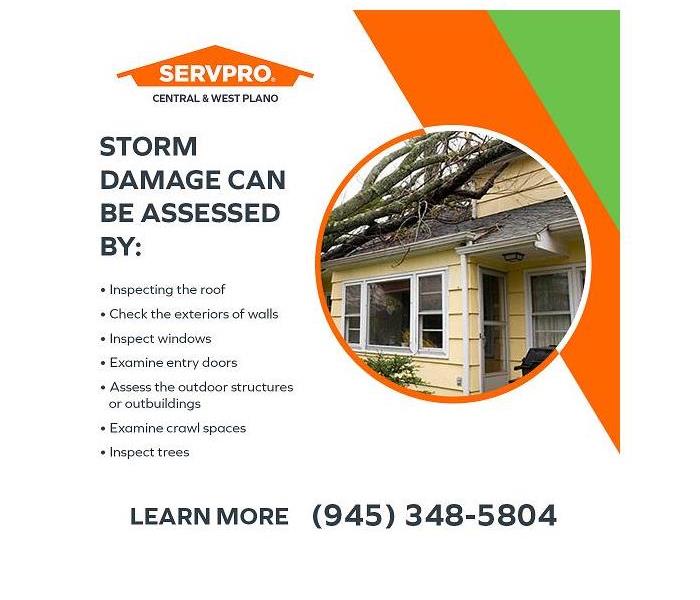Flood Restoration 101: How to Check Your Home for Storm Damage
10/9/2022 (Permalink)
Blog Summary: SERVPRO of Central & West Plano explains how to check for storm damage in homes.
Data from the National Centers For Environmental Information says there were 25 storm-related disasters in the US between 2018 and 2019. These damages cost over a billion dollars. Storm damage can be caused by sudden changes in weather patterns. The risk of flood damage has increased over the years in the US. Immediate attention from flood restoration services is necessary to limit further damage and reduce costs incurred.
Adverse weather conditions like severe thunderstorms, hurricanes, heavy rainfall, or blizzards can all lead to flood damage. Any disturbances in the environment or atmosphere that lead to severe weather can be termed storms. There are different types of storms like thunderstorms, snowstorms, rainstorms, or strong windstorms. However, flooding can also happen due to causes within a building like burst and leaking pipes, malfunctioning appliances, sewer backups, etc.
Flood restoration involves the steps of removing water, decontamination of the affected area, and restoring and repairing the building. Flood water is considered to be contaminated and the water damage it causes is categorized accordingly. SERVPRO® of Central and West Plano provides restoration services to homes and businesses in Deerfield, TX, that have sustained damage from storms and flooding. This company has highly trained technicians who respond immediately to emergencies and have the experience, expertise, and training to conduct flood restoration fast, safely, and meticulously. In this article, SERVPRO of Central and West Plano shares how a home can be checked for signs of storm damage.
Heavy rains, high winds, and lightning can all lead to storm damage to homes. Water damage can occur easily as the risk for roof and window damage is high. Sometimes the damage may not be easily visible, and the signs of storm damage may remain hidden. Identifying damage and starting flood restoration as soon as possible can limit further damage, help maintain the safety of the structure, and reduce associated costs. Storm damage can be assessed by checking the following:
1. Inspecting the roof
The roof is a prime target for storm damage. It can get damaged by heavy rainfall, hailstorms, wind, and objects carried by air falling on it. Holes in the roof, raised or missing shingles, debris like leaves accumulated in the gutters, and damage to the chimney are signs of storm damage.
2. Check the exteriors of the walls
Walls must be checked carefully for signs of damage. Some signs may not be immediately noticeable. Spider pattern of cracks (fine cracks that radiate from a central point), splits in the wall, wall paint that is chipped, small dents or holes, and damaged or missing sidings may indicate storm damage. Any damp patches on the interior or exterior of walls must also be noted.
3. Inspect windows
During storms, glass can break due to strong winds or airborne objects striking against windows. The shattered glass can allow external elements to enter the home and also cause damage to the home interiors. There can be damage that is not easily visible. Fine cracks, loose window panes, and damages like small dents and cracks, to the window frames, must be noted. In case windows are damaged, boarding up with wood planks will help protect the home from water and unwanted elements.
4. Examine entry doors
Strong winds and heavy flooding can put a strain on doors. They can fall off their hinges and develop cracks or holes. The home is then left exposed to outside elements.
5. Assess the outdoor structures or outbuildings
Decks, patios, porches, fences, and other outdoor structures can get damaged in storms. Any water pooling or damp spots near the structures must be noted. The structure must be examined for missing planks, railings and steps, cracking and chipping, and warped boards. The structures must be cleared of any debris and any loose structures secured.
6. Examine crawl spaces
Flood water and moisture can remain in a crawl space after a storm. If left unattended for a long time, this can lead to severe water damage. This is a place where flood damage restoration services are necessary. Leaking from roofs and through doors, and leaky pipes can cause water to get into the crawl space. Signs of storm damage to the crawl space include musty odors, pests, sagging floors, sloping floors, etc.
7. Inspect trees
Trees must be checked for loose or hanging branches after a storm. This is a safety risk and they may need to be trimmed.
Storms can be overwhelming for families. Minor repairs may be done by homeowners, but any significant storm damage may need flood restoration experts. Flooding after a storm is better handled by flood restoration professionals. In case of storm damage in Deerfield, TX, the number one choice for flood restoration is SERVPRO of Central and West Plano. These storm and water damage specialists respond and act immediately so that flood restoration is effective. This is a locally owned company with access to a national network of special Disaster Recovery Teams that can provide additional resources when there are catastrophic storms. Homeowners can get flood restoration in Deerfield, TX from SERVPRO of Central and West Plano by a call to (945) 348-5804.





 24/7 Emergency Service
24/7 Emergency Service
